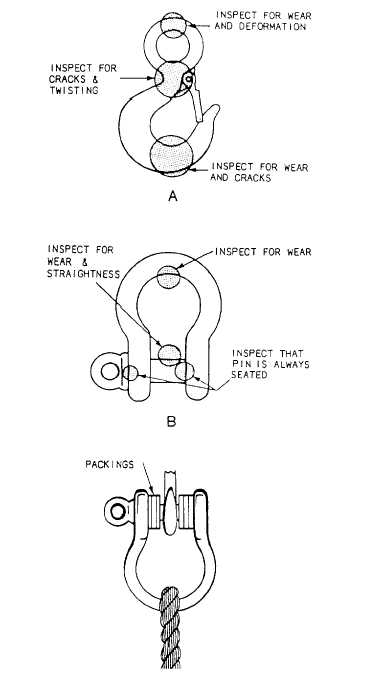these will have half of the load. To find the size of the line to use, calculate what size fiber line in a threefold block will lift 5 tons. It works out to about 4 1/2 inches.
TACKLE SAFETY PRECAUTIONS
In hoisting and moving heavy objects with blocks and tackle, stress safety for people and materials.
Always check the condition of blocks and sheaves before using them on a job to make sure they are in safe working order. See that the blocks are properly greased. Also, make sure that the line and sheave are the right size for the job.
Remember that sheaves or drums that have become worn, chipped, or corrugated must not be used because they will damage the line. Always find out whether you have enough mechanical advantage in the amount of blocks to make the load as easy to handle as possible.
Sheaves and blocks designed for use with fiber line must not be used for wire rope since they are not strong enough for that service, and the wire rope does not fit the sheave grooves. Also, sheaves and blocks built for wire rope should never be used for fiber line.
HOOKS AND SHACKLES
Hooks and shackles are handy for hauling or lifting loads without tying them directly to the object with a line or wire rope. They can be attached to wire rope, fiber line, or blocks. Shackles should be used for loads too heavy for hooks to handle.
Hooks should be inspected at the beginning of each workday and before lifting a full-rated load. Figure 4-34, view A, shows where to inspect a hook for wear and strain. Be especially careful during the inspection to look for cracks in the saddle section and at the neck of the hook.
When the load is too heavy for you to use a hook, use a shackle. Shackles, like hooks, should be inspected on a daily routine and before lifting heavy loads. Figure 4-34, view B, shows the area to look for wear.
You should never replace the shackle pin with a bolt. Never use a shackle with a bent pin, and never allow the shackle to be pulled at an angle; doing so will reduce its carrying capacity. Packing the pin with washers centralizes the shackle (figure 4-34, view B).

Figure 4-34. - Hook and shackle inspection (views A and B) and packing a shackle with washers.
If you need a hook or shackle for a job, always get it from Alfa Company. This way, you will know that it has been load tested.
Mousing is a technique often used to close the open section of a hook to keep slings, straps, and so on, from slipping off the hook (figure 4-35). To some extent, it also helps prevent straightening of the hook. Hooks may be moused with rope yarn, seizing wire, or a shackle. When using rope yarn or wire, make 8
Continue Reading